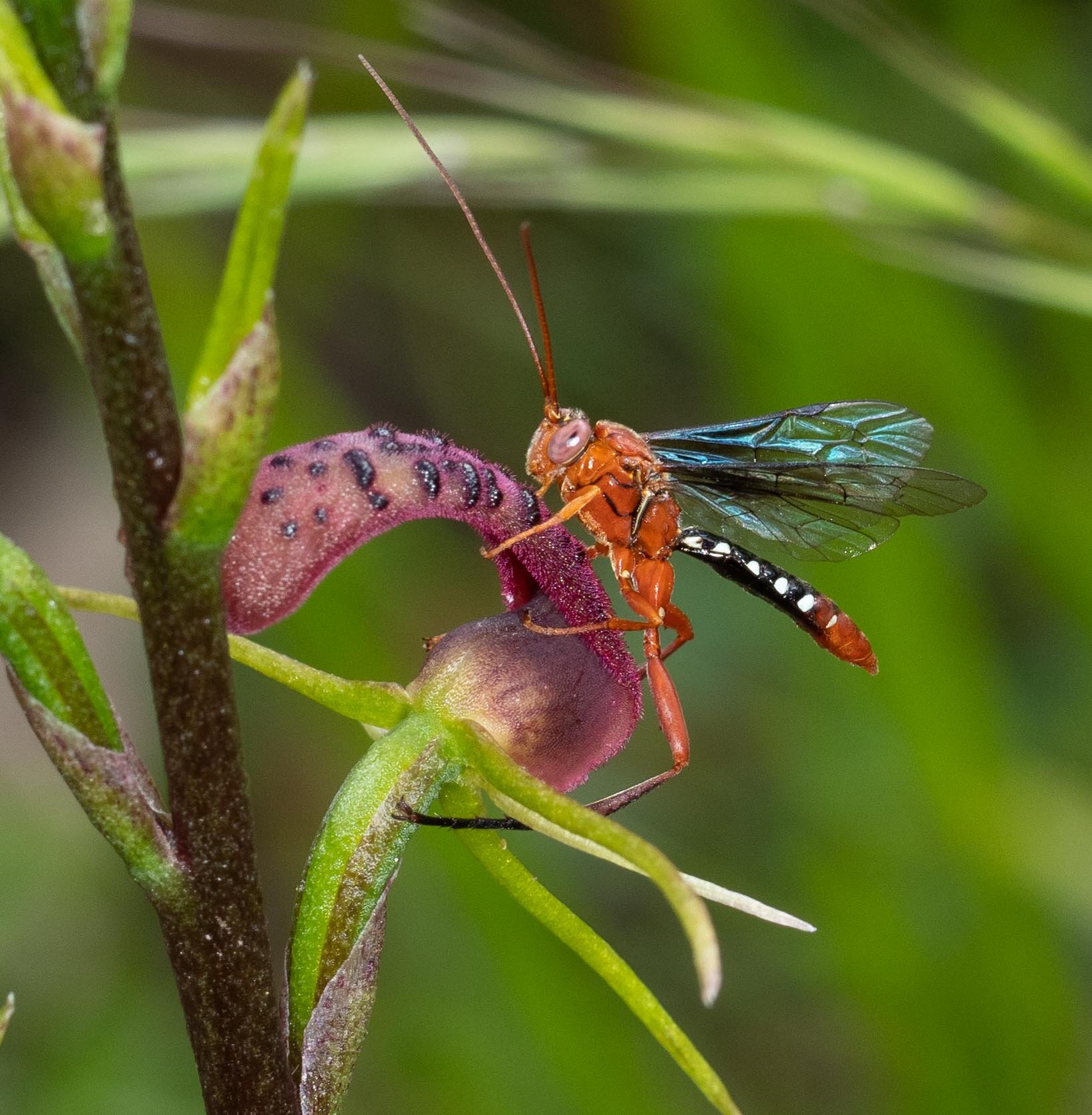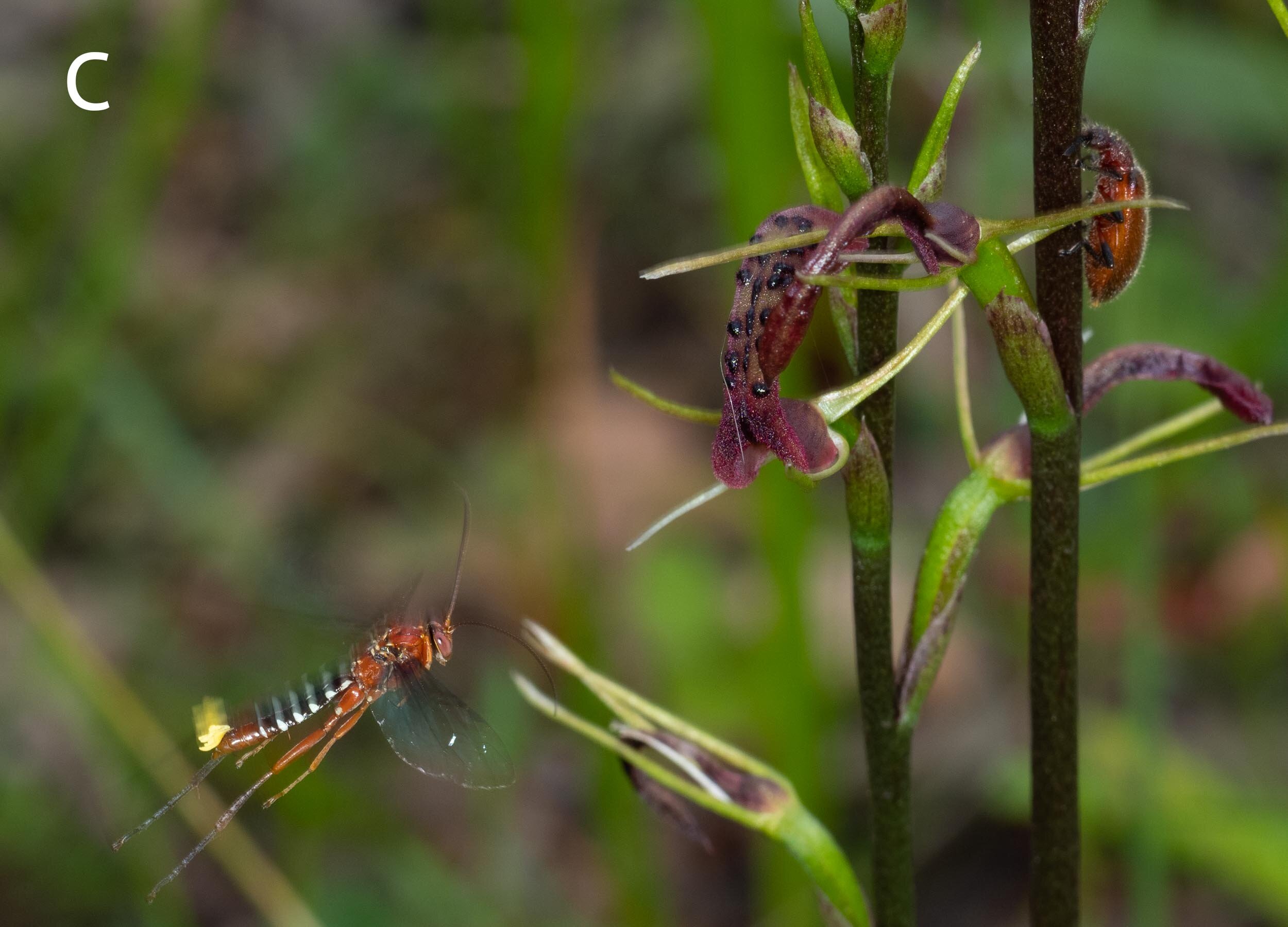Sexual deception

We’ve recently been treated to two exciting discoveries in one - a new orchid and the sight of its very special insect pollinator at work.
Sexual deceit
To attract the insects they need to carry out pollination, most flowering plants use bright floral colours and the promise of a feed of nectar. But a few, notably certain genera of orchids, do it differently - luring their insect pollinators with the prospect of sex.
Nine genera of Australian orchids are known to employ this method of sexual deceit. In fact, “Australia is the centre of diversity for sexual deception”! (ref. 1). These orchids emit chemicals that mimic the pheromones used by female insects to attract their mates. A range of insects are involved in this game, including parasitic thynnine wasps, scoliid wasps, sawflies, male ants and ichneumonid wasps.
This olfactory deception is supplemented by visual and tactile deception, which operate at close range. The orchid looks and feels, to the male insect at least, like a female. He attempts to mate with the surrogate female and in so doing picks up a packet of pollen. When this same male is attracted to another orchid, he transfers his pollen load to the receptive stigma of that orchid. Pollination ensues. The male insect is of course an inadvertent player in this game of plant sex.
Until recently, we had found 19 orchid species in our forest, four of which are in genera using sexual deceit - Caladenia, Chiloglottis and Caleana. We’d longed to see this amazing phenomenon in action, but thought our chances were slim. Following the recent discovery of a new orchid species, our wish has been granted.
The orchid
Our botanist friend Jackie Miles discovered this new orchid - actually a pair of plants growing side by side - three months ago, on 28th September, during a tour of the forest.
She recognised it as a Tongue Orchid, Cryptostylis sp. from the shape and colour of its leaf. An impressive feat, to my mind at least, especially as the leaves had large chunks taken out of them. I’m even more amazed she managed to sight it at all. It’s the only one we’ve found to date on our 4ha block.
There are four Cryptostylis species known in our region, C. subulata, C. leptochila, C. hunteriana and C. erecta. I could exclude C. hunteriana immediately as it is leafless and C. subulata and C. erecta seemed unlikely based on their leaf colour. But I’d have to wait until the plant flowered to nail its identity. These four species have very different flower shapes.
The stems were tiny at the stage we first saw the plant - only about 2cm high. Over the following weeks I followed their slow upward growth. By mid November they had grown to a height of around 20cm and what appeared to be floral buds had developed.
Then on November 29, I noticed that the lowest bud on the shorter stem had opened - giving us our first look at a flower. It looked very much like Crytostylis leptochila, the Small Tongue-Orchid, based on the shape and colour of its tongue, or labellum. However the labellum wasn’t standing erect, as descriptions of this species indicate it should.
The next time I looked, on December 3, the labellum was sagging downwards, the flower apparently senescing. None of the other flower buds had opened at that time.
Then, the following day, December 4, two new flowers had opened - one from the bud immediately above the first flower and the other from the lowest bud on the other stem.
Within 4-5 hours the labellum of these flowers moved from a forward leaning position to being fully erect, with its tip curved backwards. This revealed the surface of the tongue, with its black dimples, called calli. It’s an exact match to published images and descriptions of Cryptostylis leptochila. Both flowers were still in great shape on December 6.
So full unfurling of the flower from a closed bud is rapid, being completed within a day. The labellum remains in its erect position for two days and then gradually sags forward and withers away. Flower opening progresses in sequence from the bottom to the top of the stem. There are numerous flower buds on both stems. So I looked forward to a lot of flowering action.
That was a really nice find, but what happened next was totally amazing!
The wasp
While I was aware of the various ways in which orchids are pollinated, I wasn’t familiar with the method used by Cryptostylis orchids. Not surprising, as I hadn’t even heard of this genus before Jackie pointed it out to me. But Nature herself was about to educate me!
On December 12, I was photographing the next pair of Cryptostylis flowers that had opened. I was focussing on a beetle that was perched on one of the stems when I became aware of a wasp flying into the field of view.
It promptly landed on one of the flowers and grasped the labellum between its legs. I frantically changed my focus and fired off several shots before it flew off ten seconds later (photos A, B).
To my relief the wasp - or more correctly, a wasp, as I can’t be sure it was the same individual - returned four minutes later (photo C). This time it flew to the other flower and adopted the same position astride the labellum (photo D). It remained there for 90 seconds as you can see in the video below. Note that the wasp spends a lot of time grooming his antennae. The olfactory organs of insects are contained in the antennae and they need to keep them clean to keep their sense of smell in good shape. What could the male wasp be trying to smell on the orchid? I’ll return to this later.
Wasps made multiple visits to the flowers over the next couple of hours. They grasped the labellum in the same way everytime - full of intent. Here’s another example.
And another one. This video was taken from the same plant four weeks later, when a new flower had opened. The movie begins with a wasp attempting to copulate with the flower. You can see the end of his abdomen thrust deep inside the mouth of the labellum, where the reproductive parts of the flower are located (see photo F below). After a couple of seconds another wasp arrives on the scene. He joins the first wasp in his copulation attempt, but gives up after a while and flies off. The first one continues with his mating attempt for close to a minute.
Who is the wasp?
It was relatively easy to identify this insect as it’s a widespread, commonly sighted wasp. It’s the Dusky-winged Ichneumonid Wasp, Lissopimpla excelsa.
We’ve seen the female of this species in our forest on several occasions. Here are two photos, one taken in December 2015 and the other in November this year. You can tell it’s a female because of her long ovipositor. She uses this to deposit eggs into the body of a caterpillar. These hatch into larvae, which continue their development feeding on the body tissues of the unfortunate host. Yes, like most wasps, Lissopimpla excelsa is a parasite.
How does the male wasp pollinate the orchid?
This is what it’s all about. So let’s return to the male wasp…Look carefully at the photos and video above and you’ll see that on three occasions the male is carrying one or two small yellow packages on the end of his abdomen. What is this?
The answer is revealed when you look at the Cryptostylis labellum from the same vantage point as the male wasp in photo E. Photo F shows you what he’s gazing at. These are the male and female reproductive parts of the orchid.
The yellow object indicated by a white arrow is a pollinium (plural pollinia). It looks very much like the thing on the end of the male wasps. A pollinium is a cohesive mass of pollen - a special packaging method that has evolved in orchids. There are normally two pollinia in each Cryptostylis labellum, but in this flower the one on the opposite side (in the position indicated by black arrow) is missing.
That pollinium would have stuck to the end of the abdomen of a male wasp when he attempted to copulate with the labellum, believing it to be a female wasp.
Both pollinia are missing in the labellum in photo G. The white arrow here points to the stigma, the sticky pad onto which the male deposits the pollinia when he attempts to mate with a different flower.
This one has not yet been pollinated, although it you look closely you’ll see that an unfortunate tiny insect has stuck to the surface. There is an out-of-focus yellow smear on the stigma in photo F, which I suspect may be pollen deposited by a male wasp.
How is the male deceived?
Comparing the photos of the female Lissopimpla wasp above to the orchid labellum, you might wonder how a male wasp could mistake the latter for a mate. They look pretty different to the human eye. But that’s the point. Wasps don’t see as we do.
A 2010 study (ref. 2) showed that if you change the colours of the labellum to adjust for the spectral sensitivity of the hymenopteran visual system, you get “the perfect match”. The colours of the middle part of the labellum closely match the colours of the abdomen, wings and legs of the female wasp. And the labellum tip appears to the male wasp the same colour as the female’s thorax.
Looks aren’t the whole story
As explained at the outset, orchids don’t rely on visual deception alone to trick their insect pollinators. Cryptostylis orchids, like other genera that practice sexual deceit, supplement this with olfactory deception.
They produce a chemical that is either very similar or identical to the female Lissopimpla excelsa pheromone. This elicits an electrical response when applied to the wasp’s olfactory organ, its antennae (ref. 1).
It appears though that this chemical acts quite locally, as it can’t be detected in the air above the orchid. It may only come into play after the male wasp has landed on the labellum, convincing him he has found a mate. Recall that, during his visit to the labellum, the male spends a lot of time cleaning his olfactory organs. Makes sense.
References
Schiestl, F.P., Peakall, R. and Mant, J. (2004) Chemical communication in the sexually deceptive orchid genus Cryptostylis. Botanical Journal of the Linnaean Society 144: 199-205. Research Gate link.
Gaskett, A.C. and M.E. Herberstein. (2010) Colour mimicry and sexual deception by Tongue Orchids (Cryptostylis). Naturwissenschaften 97: 97-102. Research Gate link.






















